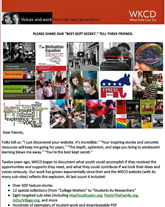 There's a radical - and wonderful - new idea here . . . that all children could and should be inventors of their own theories, critics of other people's ideas, analyzers of evidence, and makers of their own personal marks on the world." - Deborah Meier, Educator There's a radical - and wonderful - new idea here . . . that all children could and should be inventors of their own theories, critics of other people's ideas, analyzers of evidence, and makers of their own personal marks on the world." - Deborah Meier, Educator

SUBSCRIBE TO OUR NEWS BLAST
OTHER WKCD WEBSITES
First In The Family
Fires In The Mind
How Youth Learn
Social-Emotional Learning
Next Generation Press
Center for Youth Voice
In Our Village
Life in New China
SPECIAL COLLECTIONS
Advice for Parents
Student/Youth Voice
College Matters
Global Youth Voices
Just Listen!
Mentors That Matter
Service Learning
Students as Allies in School
Reform
Student Research for Action
Voices from the Middle Grades
Youth in Policy: Civics2
Youth on the Trail 2012
POPULAR WKCD PUBLICATIONS (PDFS]
A Guide to Creating Teen-
Adult Public Forums
Cultural Conversations through Creative Writing
Documenting Immigration Stories
First Ask, Then Listen: How Your Students Can Help You Teach Them Better
Making Writing Essential to
Teen Lives
Profiles of Politically Active Youth
Queer Youth Advice for Educators
SAT Bronx
The Schools We Need: Creating Small High Schools That Work for Us
| Chemistry Students Put School Bathrooms Under the Microscope
by Joanna Klonsky | This story first appeared on WKCD.org in 2007

CREEDMOOR, NC — Ever wonder what kind of bacteria is festering in public bathrooms? So did a group of high school students on Creedmoor, North Carolina. And while the average high school students stared at textbooks or memorized formulas, those students at South Granville School of Health and Life Sciences embarked on an action research project to find out just how contaminated the bathrooms in their public school were. In the process, they learned not only about Petri dishes and bacteria growth, but also about the benefits of a hands-on learning science curriculum.
The assignment in Dr. Jeff Lacosse’s honors chemistry class in the fall of 2005, says senior Nicole Miller, was to pick a project “that would help in the community.” When the girls decided to test four bathrooms in their school and two others in local restaurants for bacteria growth, Lacosse asked them to write a grant proposal to What Kids Can Do to help fund the project.
“The next thing we knew, we had won the grant for it the experiment,” says senior Alexis Franks. “We ordered all of the equipment we needed—incubators, Petri dishes, microscopes, a refrigerator, lab coats—and spent about three or four weeks learning how to use the material that we had purchased and learning how to make slides and use the Petri dishes.”
Hunting for bacteria, making an impact
The students then went from one bathroom to the next, swabbing the insides of the toilets, handles, towel dispensers, sinks, and floors. After incubating those samples, the science students discovered that the floors, not the toilets, were the most bacteria-laden section of the bathrooms. They were also surprised to find that the men’s bathrooms were “generally cleaner than women’s,” according to their study.
The group then began the second part of their project. They tested major cleaning solution brands in their bathrooms, and recommended to their school janitorial staff that they use Clorox or Comet cleansers, which, they found, worked the best to kill bacteria.
Since then, says Miller, “We actually have seen changes in some of the bathrooms.” Senior Amber Prigen adds that the bathrooms are now “more sanitary. They added more light in the bathrooms, which is better to see how dirty it really is. The upkeep is better—it used to be we really didn’t have much soap in the soap dispensers, paper towels and stuff like that.”
Going beyond “book work”
By the time the research group completed their report it was clear that it would be difficult to go back to typical science class. “I like hands-on experience better. I learn better from that and I did learn a lot from this project,” says senior Amber Prigen. So why aren’t more high school science courses oriented around this sort of action research and hands-on curriculum?
Lacosse, who oversaw the project, explains that “a lot of the teachers come in and there’s no resources to do any hands-on activities, and it’s up to the teachers themselves” to acquire the funding for such projects. Lacosse and his fellow science faculty members at South Granville have “written probably to date about $40,000 worth of grants to get most of the equipment that we have right now,” he says.
For these students, it is clear that finding that funding is worth the effort. “I’ve never had a science class that actually challenged us to use something that we were learning in the classroom in real life,” says Franks. “Everything else in Earth Science and Biology was mainly book work… We really didn’t go out into the street…I think it should be part of all curriculum in all of our science classes to at least know how you can apply this in real life.”
What Kids Can Do, Inc. | info@whatkidscando.org | www.whatkidscando.org
Copyright © 2015 What Kids Can Do, Inc.
|



